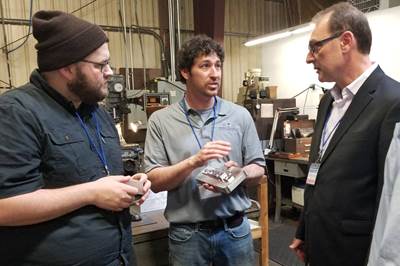
Grant funding requires a plan that aligns with a shop’s long-term needs and growth strategies. Photo Credit, all images: Getty Images
When seeking grant funding, you have two primary choices: (1) respond to a grant request generated by others or (2) work to develop grants that better suit your company’s needs. To learn how to find grants put forth by others, see the “Free Money! A Guide to Grant Funding” article in the March 2022 issue of MoldMaking Technology. Then to learn how to create a custom grant, read on.
First and foremost, you must understand that grant funding is not an easy “get rich quick” scheme. Whichever path you choose, it requires diligent and creative effort. It is not a “cash cow” to provide quick funding for your shop to spend as it sees fit. Instead, it needs to be a planned and determined effort that aligns with your company’s long-term needs and growth strategies.
It would be best to appoint someone in your marketing department to spearhead your company efforts to seek grant funding, fully realizing that in a small company, that person probably already wears several hats and is overworked as is. As many of us know, such is the nature of building a manufacturing business from the ground up.
Your goal is not to create a single grant opportunity, but to develop a process and a network of companies and organizations that can create multiple opportunities as time passes and as you become more proficient at driving these opportunities.
Steps to Grant Writing
Join forces. An essential aspect of creating a grant is to realize that you will not be the single beneficiary of such a grant, nor will it necessarily fund your pet project. Therefore, without exception, you will be much more successful in creating a grant by finding other companies or organizations with similar needs to join you.

Write your draft proposal using concise sentences and avoiding long run-on sentences.
Identify the desired outcome. Find an organization with the necessary financial resources and interest in funding your grant. The most likely funding sources — though not the only ones — for the average manufacturing business are state legislatures or private benevolent/public-spirited groups. Once you identify a potential funding source, consider what outcome will most interest that funding source.
For example, suppose it is a state legislative body. In that case, their primary goal will typically be creating jobs and developing resources that ultimately create jobs or some other civic function, such as addressing pollution. But, on the other hand, if it is a benevolent group, they will more likely be interested in an outcome other than job creation.
The state legislature of Indiana created a Manufacturing Readiness Grant that benefits diverse businesses, including several within the moldmaking community. In addition, a private association called the Recycling Partnership’s Polypropylene (PP) Recycling Coalition provides numerous grants to companies working in plastics recycling. Grants range from a few hundred thousand to millions of dollars, so being a private/public-spirited group does not indicate minimal financial resources.

The key to a successful grant is finding other companies or organizations with similar needs to join your business.
Build state/local relationships. To generate state funding for grants, get to know your state legislator and work to determine what would motivate them to champion a grant within the state legislature. Also, get involved with state-sponsored manufacturing advocacy agencies at the state and local levels. For example, each state typically has the equivalent of state and county economic development agencies. These groups are administrative arms of the state and county legislatures/commissions that advocate for various business development and growth opportunities within their respective political subdivisions.
Please acquaint yourself with other companies in your state that are members of the state-sponsored agency and work with them to create grant opportunities that interest you, them and your state legislature. Also, work through your local government advocacy affiliate and the companies within your district or county to create grant opportunities. Consider including companies and organizations in nearby counties as well.
Partner up with schools. In addition to the above, note that partnering with various educational institutions, from local high schools to nearby state-sponsored colleges or extension campuses, is almost always beneficial to your efforts. The inclusion of career technical education centers is usually advantageous to your endeavor. Concerning each of these institutions, creating opportunities for students to get hands-on experiences is always a good strategy.
A Word of Caution
Just because you are the driving force behind creating a grant does not mean you can be sloppy or cavalier in responding to the formal grant request. Here are the rules for responding to a grant solicitation:

Follow proposal instructions precisely.
- Read the solicitation very carefully. Reread it. Highlight each critical point. Do not skip over seemingly unimportant points. Understand what the grant will and will not fund.
- Be sure that you understand thoroughly what the grant solicitor expects from a successful outcome of the grant funding or know what questions still need to be answered by the grant solicitor.
- If possible (and it usually is for the state- and locally funded grants), speak with those who wrote the grant solicitation. Learn what they think is essential. Listen carefully for keywords and phrases, particularly those that are repeated.
- Ensure you understand how the words and phrases in the written solicitation align with what was aided by those key people to whom you spoke with.
- Write down the keywords and phrases and determine how you plan to incorporate them logically into your proposal.
- Follow the proposal instructions precisely. Do not assume.
- Write your draft proposal. Use concise sentences and avoid long run-on sentences. Use bullet points whenever reasonably feasible.
- Do not use acronyms or colloquial expressions without explanation. Do not assume the reader knows them because they are familiar to you.
- Review. Get others to read and critique your proposal, including personnel from associated agencies.
- Plan to submit your proposal several days ahead of the required submission date. Follow submission instructions.
- You will likely need an Executive Summary: Who, what, why, where and when, and approximately 750 words. Remember that this is the only part of the proposal they will read for some evaluators. This is your sales pitch.
- You will need to present the qualifications of company personnel who will ensure the grant’s goals can be met.
- The body (the heart) of the proposal should explain in detail how your company will complete the project on a timely basis while achieving the goals of the grant. However, do not oversell.
- Describe what your company will do after the grand funding is expended. Explain how the project is expected to proceed with and without grant funding, showing dedication to the project even if the timeline changes.
- Once awards have been made, request a debriefing of your proposal by the soliciting agency, highlighting the strengths and weaknesses of your proposal, particularly if you did not win an award.
- Learn from your effort to win an award next time and every time after that.

An important step to creating a grant is understanding that you will not be the only beneficiary.
Read and follow these rules implicitly. Do not assume you will automatically be awarded one of the grants because you initiated a particular grant opportunity. And remember, your goal is not to create a single grant opportunity, but to develop a process and a network of companies and organizations that can create multiple opportunities as time passes and as you become more proficient at driving these opportunities.
Related Content
MMT Chats: Solving Schedule and Capacity Challenges With ERP
For this MMT Chat, my guests hail from Omega Tool of Menomonee Falls, Wisconsin, who share their journey with using enterprise resource planning (ERP)—and their people—to solve their schedule and capacity load monitoring challenges.
Read MoreThe Trifecta of Competitive Toolmaking
Process, technology and people form the foundations of the business philosophy in place at Eifel Mold & Engineering.
Read MoreThink Safety: Eliminate Hazards Throughout the Shop
The tooling community is taking advantage of new products for safer mold shops and molding facilities.
Read MoreMold Design Review: The Complete Checklist
Gerardo (Jerry) Miranda III, former global tooling manager for Oakley sunglasses, reshares his complete mold design checklist, an essential part of the product time and cost-to-market process.
Read MoreRead Next
Free Money! A Guide to Grant Funding
Understanding grants and identifying all available funding sources will help mold builders secure grant money.
Read MoreTwelve Steps to Make the Right Investment Decisions
Set criteria and use a process when making investment decisions with the team.
Read More.jpg;maxWidth=970;quality=90)




















